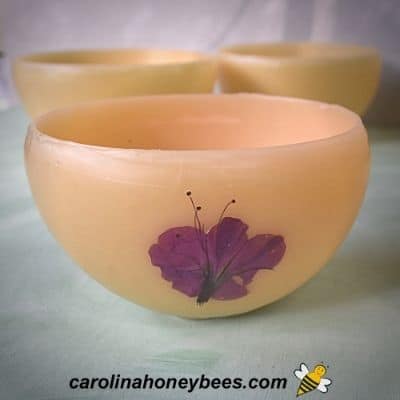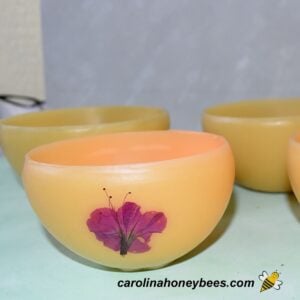How to Make Beeswax Luminaries
Crafting beeswax luminaries is not just a delightful pastime – it is also a great way to bring natural light into your life. This beautiful project adds warmth and ambiance to any space. A natural option to regular paraffin, the light honey scent and golden glow is so charming. Use these easy step by step instructions to make your own beeswax luminaires.

Using beeswax for crafting promises so many possibilities for fun. You will never have time to complete them all-but this doesn’t mean you should not try!
DIY Beeswax Lantern Luminaries
Homemade luminaires were traditionally used by Spanish peoples around the holidays. But, the idea is thought to have originated after early explorers were impressed with Japanese lanterns.
No doubt about it. Handmade luminaires are beautiful and offer a subtle lighting experience. There are many ways to make them. Some are one time use and others can be reused. These can be used over and over by adding a tealight inside.

Basic Materials
- beeswax
- balloons
- sand (optional)
Beeswax
You can purchase beeswax that is ready to use or buy raw beeswax from a local beekeeper. Regardless of which type you choose – be sure you use cleaned beeswax. Bits of dirt will not look nice in your luminary.
Balloons
Medium sized regular balloons are best for this wax luminaries project. You will not be blowing them up to full size – so having at least medium sized ones is easiest. You can certainly make larger ones if you want – or smaller.

Sand
Placing a bit of sand in the bottom of your beeswax lanterns is a good idea to prolong their useful life. This helps displace the heat and keep the bottom from melting. Use plain play sand or colored decorative sand if you wish-you will only need a small amount. A tealight can bring your creation to life.

Decorate Wax Lanterns with Dried Flowers (Optional)
If you would like to add some floral decorations to your beeswax lantern it is easy to do. After the lantern reaches your desired thickness, let it cool for a few minutes.
Then, carefully use a glue stick to adhere pressed flowers to the outside of your lantern. Make one final quick dip in the melted beeswax and set aside to let cool. Flat thin flowers give the best results. I also use these for my beeswax wax sachets.
The Process

1. Here are the basic steps (more details below). Fill the balloon about 1/3 to 1/2 full with water and tie neck.
2. Safely, melt beeswax ( a double boiler set up is best). You need much more wax that will actually be used because you are making a dipping vat.
3. Slowly, dip the balloon into the melted wax. Do not dip below the water line. (i.e. Any part of the balloon that is dipped in the wax should have water inside.)
4. You will repeat this process for several dips. Letting the piece cool for a few minutes in between dips. When you are please with the thickness. Set aside and let your beeswax luminary cool. Then, pop the balloon.

Finishing
You may leave your luminaries plain (no flowers) but you do need to do a few polishing tips. Use a heated surface (protected by foil or similar of course) to level the base a bit.
I like to pour just a bit more melted wax into the piece at this time to thicken the base. Lastly, use a knife, scissors or similar to smooth the top edges.
How to Use Wax Luminaries
After everything cools, you can place a tealight inside or a votive candle in a holder and enjoy. The melting point of beeswax is about 147°F.
Using a “holder” under the lit candle helps prevent any melting in the bottom of your luminaire. You may also add some sand (even colored sand) in the bottom. This helps insulate the wax bottom from the heat of the tealight.
Important note to remember. Beeswax is flammable. Do not allow flame to come in contact with your beeswax luminaire.
At best, it will melt and at worse it will catch fire. Always use under constant supervision with care to prevent burns or fire. Of course, these are just one type of luminaires, there are many other kinds to make and enjoy.

Expert Tips
Depending on how many beeswax lanterns you are making, you may need to add more beeswax to your melting basin.
Keep that in mind when you are deciding what type of dipping basin to use and when buying the beeswax for your project.
Beeswax has a higher melting point than some waxes – these instructions are for beeswax. If your beeswax luminary cracks when you set it down after the first few dips, the balloon is not tight enough. Try again after adding more water to the balloon.
The larger luminaire you make the larger your melting pot must be about 6 inches of melted wax is good. Don’t overfill the pot, you must leave room for the wax level to rise when you dip the balloon
If melting wax in the crockpot (a good way to render beeswax too), be advised that it will take quite a while to melt – the double boiler method is faster.
If the beeswax is too hot, it may pop the balloon. Repeated dips not increasing the thickness? – your wax is too hot
More Ideas
While you have a little beeswax left – maybe you should try some Herbal Wax Sachets or natural Wax Melts. If you have a couple of clay cookie molds on hand – these DIY beeswax ornaments are a lovely addition to the holiday.
If you want to warm up on a very simple candle project first – I recommend the DIY Beeswax Candle Recipe Project.
Finally
Enjoy the golden warm of beeswax light with your homemade beeswax luminaries. These are beautiful creations whether plain or decorated with flowers. And they smell so good. If you like someone really well – perhaps you will make one for them too.

Beeswax Lantern Tutorial
This post may contain affiliate links. As an Amazon Associate, I earn from qualifying purchases.
Read my Disclosure.Tools
- scissors
Supplies
- 2 pounds beeswax
- 6 piece balloons – round medium
- 1 roll Parchment Paper or equivalent
Instructions
- Fill balloons with warm (not hot) water. Place mouth of balloon over faucet and fill. How much water should you put in there? It depends on how large you want your beeswax luminaries to be. Don’t overfill your balloons but they should be tight and firm. This gives the beeswax base the support needed to maintain its shape in the early stages.Remove from faucet and tip a knot in the balloon. Dry off any water – it should be dry before dipping in the hot wax.

- Heat your beeswax to about 160°F but not over 170°F in a double boiler set up. You can use a regular double-boiler if you have one dedicated to beeswax crafts. (And you really should as it is very hard to get all the wax out when you are done.)You can also use a slow cooker or crock pot to heat wax. By using a crockpot liner, cleanup should be very easy. This is a great way to make beeswax lanterns for a group where you have several people creating them at one time.

- When the pot of wax is completely melted, pick up your water filled balloon. Smoothing dip it 4 or 5 times in the beeswax but do not dip it in further than the water line. Doing so will cause the balloon to burst and make a graciously big mess.If you have a smooth dipping technique you will have a smoother finished product. Hesitating or stopping half way will cause a dip line in your beeswax luminaire.Try to dip in to the same depth each time.

- After 5 or so dips, carefully set the beeswax coated balloon down to cool on a piece of parchment paper. Let the wax harden by cooling the balloon for 5-6 minutes. Then repeat the process until you have a total of 25-30 dips. Our goal is to have it thick enough to be sturdy for handing but still thin enough to let light show through.If you choose to make several at a time, you can dip others while some are in the cooling phase. The number of dips needed to make your beeswax luminaire depends a bit on personal preference.

- After the final dip, carefully set your beeswax luminaries down on the parchment paper and let the wax cool until it is firm but still warm to the touch.

- Place your beeswax lantern over a dishpan or the sink and use a pin to pop the water balloon. Carefully, pour out the water and peel off the balloon.

- Use scissors or an exacto knife to trim away any rough edges on the top.

- Using a hot plate or warm flat pan covered in foil, set the beeswax luminaire down for just a few seconds to create a smooth bottom. Don’t leave it on long enough to melt through. This can be done before or after smoothing the top edges.

- Let cool again and then pour a bit of melted beeswax in the bottom inside to give the item a thick base. Let cool completely.











